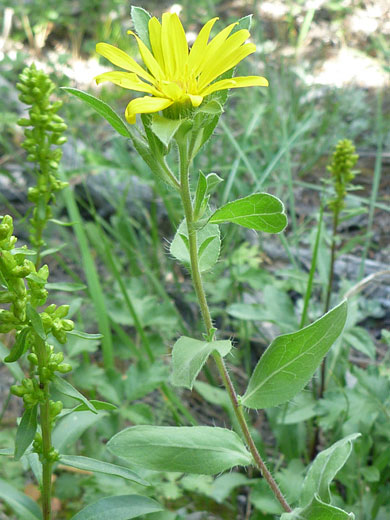Heterotheca Fulcrata, Rockyscree False Goldenaster
Plants > Wildflowers > Asteraceae > Heterotheca Fulcrata
Common name:
Rockyscree false goldenaster
Family:
Scientific name:
Heterotheca fulcrata
Main flower color:
Range:
Between Idaho and far west Texas
Height:
Between 10 and 24 inches
Habitat:
Woodland clearings, hillsides, meadows, in the subalpine and montane zones; up to 11,500 feet
Leaves:
Lanceolate, alternate, up to 2 inches long, tapering to a short spine. Hairy, especially along the edges
Season:
July to September
Heterotheca fulcrata resembles numerous other sunflower-like plants of the asteraceae family; identifying features include the long, quite well-separated hairs along the leaf edges and the reddish-green stems, and the relatively large leaves that grow right beneath the flowerhead, projecting out beyond the petals. The bright yellow ray florets usually number between 11 and 21, disc florets between 26 and 66. Phyllaries are also hairy, and lanceolate in shape, and occur in 4 or 5 rows. They are usually not glandular (ie not sticky). Some are elongated (over half an inch) to form leaf-like bracts, and are also visible when looking at the flower from above. There are several varieties of this species, differing in the type and distribution of the leaf hairs, the shape of the phyllaries and the glandularity of the leaves.
All Contents © Copyright The American Southwest | Comments and Questions | Contribute | Site Map


